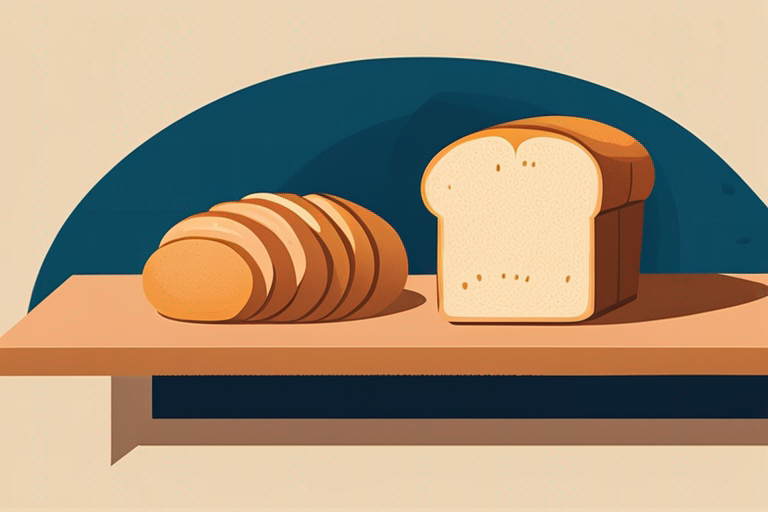
Is Your Whole Wheat Sliced Bread Still Good to Eat?
Get Your Free Food Safety Cheat Sheet
30 most common foods with instant answers. Print it and stick it on your fridge—completely free!
Is Your Whole Wheat Sliced Bread Still Good to Eat?
When it comes to food safety, knowing how to determine if your whole wheat sliced bread has gone bad is crucial. Bread is a staple in many households, and it's important to ensure that you are consuming it while it's still fresh and safe to eat. In this blog post, we will explore the signs of spoilage in whole wheat sliced bread and provide you with practical tips on how to store it properly to extend its shelf life.
Understanding the Shelf Life of Whole Wheat Sliced Bread
Whole wheat sliced bread typically has a shelf life of about 5-7 days when stored at room temperature. However, several factors can affect its freshness and longevity. It's essential to consider the following when determining if your bread has gone bad:
Signs of Spoilage in Whole Wheat Sliced Bread
-
Mold Growth: Mold is a common sign that your bread has spoiled. If you notice any green, white, or black spots on the surface of the bread, it's best to discard it immediately.
-
Stale Texture: As bread ages, it tends to become dry and stale. If your whole wheat sliced bread feels tough or crumbly instead of soft and springy, it may be past its prime.
-
Unpleasant Odor: Fresh bread has a pleasant, yeasty aroma. If your whole wheat sliced bread smells sour, musty, or off-putting, it's a sign that it has started to spoil.
-
Visible Signs of Decay: Inspect the bread for any signs of physical decay, such as excessive moisture, discolored patches, or a slimy texture. These are clear indicators that the bread is no longer safe to eat.
Tips for Properly Storing Whole Wheat Sliced Bread
To maximize the shelf life of your whole wheat sliced bread and maintain its freshness, consider the following storage tips:
-
Room Temperature: Store your bread in a cool, dry place away from direct sunlight and heat sources. A bread box or a pantry shelf is ideal for keeping whole wheat sliced bread fresh.
-
Refrigeration: If you live in a hot and humid climate, refrigerating your bread can help prevent mold growth and extend its freshness. However, refrigeration can accelerate staling, so be mindful of the trade-off.
-
Freezing: For long-term storage, consider freezing your whole wheat sliced bread. Wrap it tightly in plastic wrap or aluminum foil before placing it in the freezer. To thaw, leave it at room temperature or reheat it in the oven.
-
Avoid Moisture: Moisture promotes mold growth and accelerates spoilage. Keep your bread in a breathable container or paper bag to prevent condensation from forming.
Conclusion
In conclusion, keeping an eye out for the signs of spoilage in whole wheat sliced bread is essential for maintaining food safety. By understanding the shelf life of bread and following proper storage practices, you can enjoy fresh and delicious slices for longer. Remember to trust your senses and use your best judgment when determining if your bread is still good to eat. Stay informed, stay safe, and savor every bite of your favorite whole wheat sliced bread!

Authoritative Food Safety References
These agencies and university labs inform every tip and health precaution we publish.
USDA FoodKeeper – Cold Storage Guidelines
Official refrigerator, freezer, and pantry timelines maintained by the U.S. Department of Agriculture.
Visit USDA FoodKeeperFDA Produce Safety Rule & Grower Guidance
Field-to-fridge handling practices that prevent contamination of fruits, vegetables, and leafy greens.
Visit FDA Produce SafetyCDC Foodborne Illness Prevention Hub
Surveillance-backed guidance on pathogens, symptoms, and steps to reduce foodborne illness risk.
Visit CDC Food SafetyUC Davis Postharvest Technology Center
University research detailing optimal storage atmospheres for produce after harvest.
Visit UC Davis PostharvestPenn State Extension – Home Food Preservation & Safety
Peer-reviewed extension bulletins on safe canning, chilling, and reheating practices.
Visit Penn State ExtensionHow can I tell if my whole wheat sliced bread has gone bad?
Can I freeze whole wheat sliced bread to prolong its shelf life?
How should I store whole wheat sliced bread to keep it fresh?
Can I still eat whole wheat sliced bread if it has a few spots of mold?
Get Your Free Food Safety Cheat Sheet
30 most common foods with instant answers. Print it and stick it on your fridge—completely free! Want more? Upgrade to the complete guide with 70+ foods.
Scan your food directly and get instant safety info using our AI-powered camera feature.